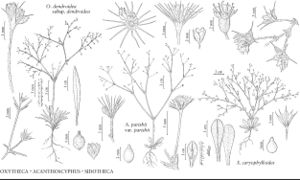Sidotheca
Harvard Pap. Bot. 9: 211. 2004.
| Taxon | Illustrator ⠉ | |
|---|---|---|
 | Oxytheca dendroidea subsp. dendroidea Acanthoscyphus parishii var. parishii Sidotheca caryophylloides |
Herbs, annual; taproots slender. Stems arising directly from the root, spreading or prostrate, sometimes erect, solid, not fistulose or disarticulating into ringlike segments, glabrous or sparsely glandular. Leaves persistent or quickly deciduous, basal, rosulate; petioles indistinct; blade broadly linear or spatulate to oblanceolate, margins entire, strigose and glandular. Inflorescences terminal, cymose; branches mostly dichotomous, not brittle or disarticulating into segments, round, glabrous or sparsely glandular; bracts (2–) 3 (–4) at first node, 2–3 at distal nodes, distinct or connate, often positioned to side of node, scalelike, triangular or linear to ovate and 3-lobed, awned, sparsely glandular. Peduncles present or absent, erect to spreading. Involucres 1 per node, not ribbed, tubular, narrowly turbinate to funnelform; teeth 5 (–6), awn-tipped. Flowers 2–5 (–10) per involucre at any single time during full anthesis; perianth white to rose or greenish yellow to red, funnelform when open, tubular when closed, hirsute and sparsely glandular abaxially; tepals 6, connate 1/4–1/3 their length, monomorphic, 3–5-lobed or laciniate apically; stamens 9; filaments basally adnate, glabrous or minutely papillate basally; anthers red to maroon, ellipsoid or oblong to oval. Achenes usually included, golden to redbrown, not winged, 3-gonous, glabrous. Seeds: embryo curved. x = 20.
Distribution
Calif., nw Mexico
Discussion
Species 3 (3 in the flora).
Sidotheca is allied to Eriogonum subg. Ganysma, approaching E. inerme in terms of foliar and overall habit. The trilobed to laciniate tepals resemble those of certain species of Chorizanthe. It is possible, as B. Ertter (1980) suggested, that the taxon was derived from Acanthoscyphus. In the 1950s, G. J. Goodman (1904–1999) proposed its recognition at generic rank, using the parahomonym “Neoxytheca.”
Selected References
Key
| 1 | Involucres funnelform, white-margined, bracts connate more than 3/ 4 their length; tepals 3-5-lobed apically, lobes laciniate | Sidotheca emarginata |
| 1 | Involucres narrowly to broadly turbinate, concolored, bracts connate ca. 1/ 2 their length; tepals 3-lobed apically, lobes laciniate or not | > 2 |
| 2 | Perianths 1-2 mm, greenish yellow to red; tepals 3-lobed apically 1/ 5 their length; peduncles present or absent; awns of involucral bracts 0.3-1 mm; awns of inflorescence bracts 0.2-0.5 mm | Sidotheca caryophylloides |
| 2 | Perianths 2.5-4 mm, white to pink; tepals 3-lobed apically 1/ 1/ 2 their length; peduncles present; awns of involucral bracts 0.3-2 mm; awns of inflorescence bracts 0.8-1 mm | Sidotheca trilobata |
"/2" is not declared as a valid unit of measurement for this property.